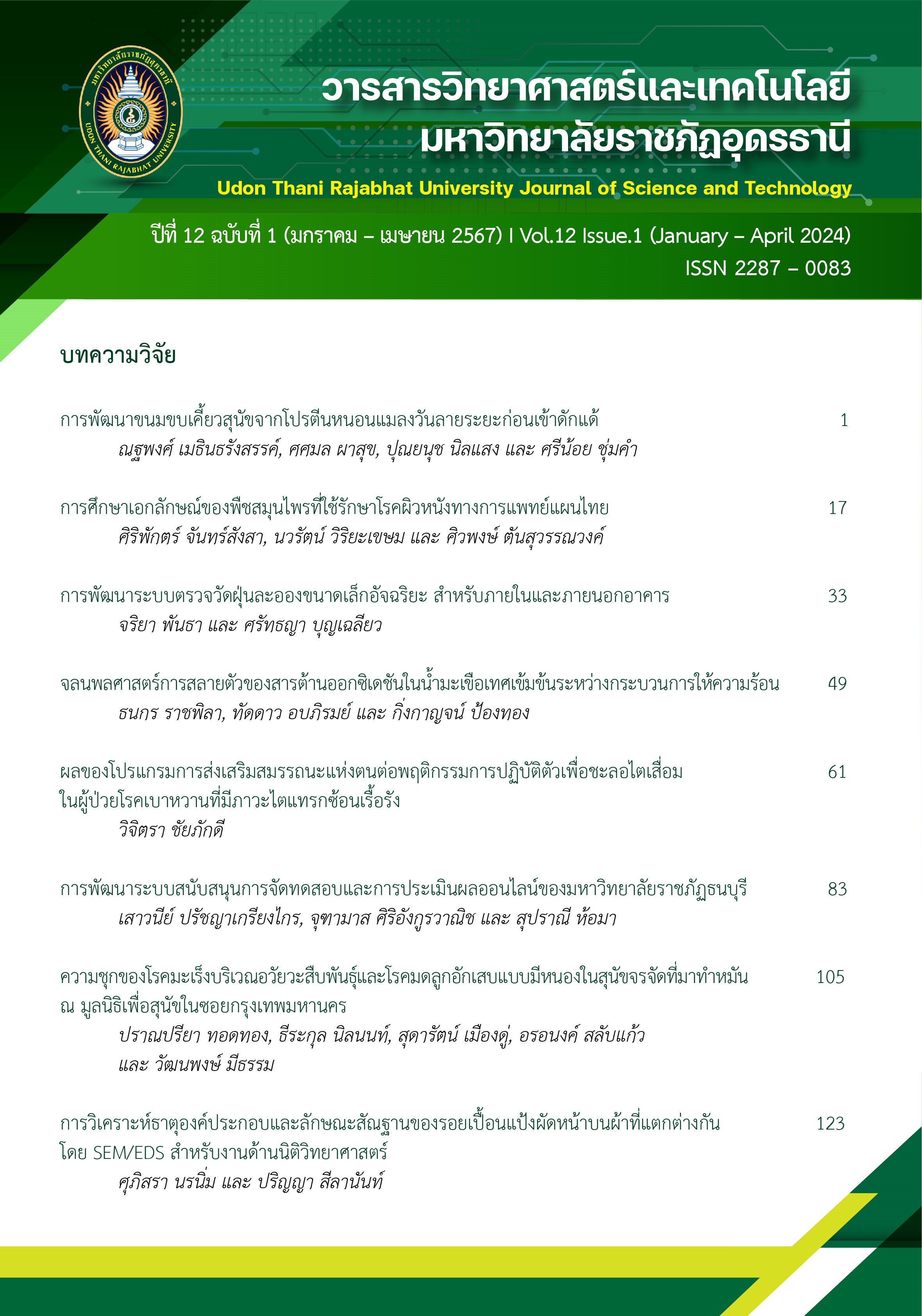DEVELOPMENT OF AN INTELLIGENT SYSTEM FOR PARTICULATE MATTER AIR POLLUTION MONITORING FOR INDOOR AND OUTDOOR ENVIRONMENTS
Main Article Content
Abstract
This research reports the development of a fine dust monitoring system at PM 2.5 level. The system is able to measure and report dust values in real time in both indoor and outdoor environments. The results of the test measuring the amount of PM 2.5 dust in the air for an average of 24 consecutive hours for 16 days using the dust measuring device developed by the researchers showed a graph trend of dust levels that were similar to or in the same direction as the standard equipment of the Pollution Control Department installed at the OTOP Center, Tambon Nai Mueang, Mueang Ubon Ratchathani District, Ubon Ratchathani Province, with an average dust concentration difference of 6 micrograms per cubic meter. The research results showed that the developed prototype can be used. In addition, the dust monitoring system can retrieve statistical information of real-time and past time and certain data depicted in the forms of graphs and tables exhibiting dust particle levels on website through web browsers on computers and smart phones. Moreover, there is an alert system of the exceeding pollution value through LINE application when the set standard value is exceeded.
Article Details
References
กรมควบคุมมลพิษ. (2561). โครงการศึกษาแหล่งกำเนิดและแนวทางการจัดการฝุ่นละอองขนาดไม่เกิน 2.5 ไมครอน ในพื้นที่กรุงเทพและปริมณฑล. สืบค้นเมื่อวันที่ 27 ตุลาคม 2566, จาก https://www.pcd.go.th/wp-content/uploads/2020/06/pcdnew-2020-06-05_02-34-12_147817.pdf.
กรมควบคุมมลพิษ. (2565). ประกาศคณะกรรมการสิ่งแวดล้อมแห่งชาติ เรื่องกำหนดมาตรฐานฝุ่นละอองขนาดไม่เกิน 2.5 ไมครอน ในบรรยากาศโดยทั่วไป พ.ศ. 2565. สืบค้นเมื่อวันที่ 27 ตุลาคม 2566, จาก https://www.pcd.go.th/laws/26439.
กรมควบคุมมลพิษ. (2565). รายงานสถานการณ์และการจัดการปัญหามลพิษทางอากาศและเสียงของประเทศไทย ปี 2565. สืบค้นเมื่อวันที่ 27 ตุลาคม 2566, จาก https://www.pcd.go.th/publication/30447.
กรมควบคุมโรค กระทรวงสาธารณสุข. (2565). แนวทางมาตรการ การเฝ้าระวังสุขภาพ และสื่อสารความเสี่ยง เพื่อสร้างความรอบรู้ที่เกี่ยวข้องกับฝุ่นละอองขนาดไม่เกิน 2.5 ไมครอน(PM2.5). สืบค้นเมื่อวันที่ 30 ตุลาคม 2566, จาก https://ddc.moph.go.th/uploads/publish/1287120220815094919.pdf.
กรมอนามัย. (2565). ประกาศกรมอนามัย เรื่องค่าเฝ้าระวังคุณภาพอากาศภายในอาคารสาธารณะ พ.ศ. 2565. สืบค้นเมื่อวันที่ 30 ตุลาคม 2566, จาก https://laws.anamai.moph.go.th/th/practices/211864.
กลุ่มเฝ้าระวังฝุ่น จุฬาลงกรณ์มหาวิทยาลัย. (2562). เรียนรู้ อยู่กับฝุ่น PM2.5. สืบค้นเมื่อวันที่ 3 พฤศจิกายน 2566, จาก https://www.chula.ac.th/protect-yourself-from-pm2-5-air-pollution-and-hazardous-dust/.
ชัยวุฒิ วุทธิสิทธิ์. (2560). ระบบเฝ้าระวังคุณภาพอากาศสำหรับประเมินผลกระทบต่อสุขภาพโดยใช้เทคโนโลยีอินเทอร์เน็ทของทุกสรรพสิ่ง. วารสารวิทยาศาสตร์และเทคโนโลยี มหาวิทยาลัยราชภัฏนครราชสีมา, 2(1), 1-9.
ชาคริต โชติอมรศักดิ์ และ ดวงนภา ลาภใหญ่. (2561). ปัจจัยทางอุตุนิยมวิทยาที่สัมพันธ์ต่อการเกิดปัญหามลพิษทางอากาศในจังหวัดเชียงใหม่. วารสารหน่วยวิจัยวิทยาศาสตร์ เทคโนโลยี และสิ่งแวดล้อมเพื่อการเรียนรู้, 9(2), 237-249.
ฐิฏาพร สุภาษี, พานิช อินต๊ะ, เสริมเกียรติ จอมจันทร์ยอง และ เศรษฐ์ สัมภัตตะกุล. (2561). การวิเคราะห์ปริมาณฝุ่นละออง เชิงมวล PM2.5 และ PM10 ในบรรยากาศด้วยเครื่อง ตรวจวัดฝุ่นละอองไร้สายในพื้นที่ภาคเหนือของประเทศไทย. วารสารวิจัยเทคโนโลยีและนวัตกรรม มหาวิทยาลัยราชมงคลล้านนา, 2(1), 69-83.
ลัดดาวัลย์ จำปา. (2565). การพัฒนาเครื่องวัดปริมาณฝุ่นละอองขนาดไม่เกิน 2.5 ไมครอนที่ใช้เซนเซอร์วัดปริมาณฝุ่นละอองและแจ้งเตือนผ่านทางแอปพลิเคชัน. วารสารวิทยาศาสตร์และเทคโนโลยี มหาวิทยาลัยอุบลราชธานี, 24(2), 48-55.


